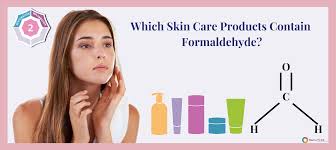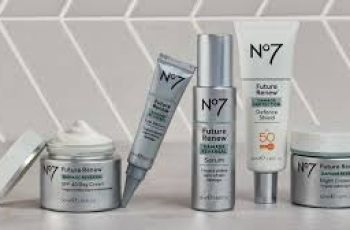
Formaldehyde Free Skin Care and Formaldehyde Allergy
Formaldehyde Allergy To Skin Care Products
Do you have a formaldehyde allergy? If so, you need to avoid it in skin care products. It is one of the most common allergens in skin care products.
How to know if formaldehyde is in a skin care product, cosmetic or beauty product? Look for formaldehyde or formaldehyde- releasing ingredients on the skin care product label.
You will find a list of products that contain formaldehyde in this blog.
Formaldehyde and formaldehyde-releasing preservatives are in the top five of the most common ingredients to cause an allergy to skin care products. (1,2)
Formaldehyde is used in cosmetics as a preservative. However, the chemical name formaldehyde itself is rarely used on skincare labels due to bad publicity from frequent formaldehyde allergy – consumers know to avoid formaldehyde in skin care because of side effects such as skin irritation and allergic reactions. Instead, companies use other ingredients called formaldehyde-releasing preservative (FRPs). 56
Formaldehyde
List of ingredients to avoid if you have formaldehyde allergy
Formaldehyde Releasing Preservatives List
2-bromo-2-nitropropane-1,3-diol
Bromonitropropane diol (Bronopol)
Diazolidinyl urea (Germall II)
DMDM hydantoin
Glyoxal
Imidazolidinyl urea (Germall)
Polyoxymethylene urea
Quaternium 15
Sodium Hydroxymethylglycinate
What beauty products contain formaldehyde and formaldehyde releasers?
Formaldehyde is in skin care products, hair straightening products and mascara and some nail polishes. The widespread use of formaldehyde containing masks during the Covid-19 pandemic, the incidence formaldehyde allergy increased. (3,4)
A 2015 study determined that long storage times and higher temperatures can increase the incidence of allergic reactions from formaldehyde and formaldehyde releasing ingredients. (5)
Formaldehyde Releasing Preservatives (FRPs) are among the most allergenic substances found in cosmetic products, making them a leading cause of contact dermatitis. Notably, these formaldehyde allergy reactions often manifest as eyelid dermatitis, resulting from the application of nail hardeners, lacquers, or makeup, such as mascara, blush, eye shadow, and foundation, all of which frequently contain FRPs. Furthermore, these preservatives can also be found in everyday items like shampoos, permanent-press clothing, cleaning agents, baby wipes, disinfectants, and even the sweetener aspartame. They are particularly problematic as they can be hidden within products marketed as “natural.” Interestingly, despite their potential for inducing sensitivity reactions, FRPs are still relatively prevalent in consumer products due to their effective antibacterial properties. The symptoms typically present as inflammation and redness in the areas of application, which can further develop into a more severe condition if left unchecked. Additionally, indirect exposure through cigarette smoke also poses risks, underscoring the ubiquity and potential harm of these preservatives.
What products contain formaldehyde
Shopping for Formaldehyde Free skin care
When you have a formaldehyde allergy, shopping for cosmetic is difficult. When seeking skin care products free of Formaldehyde Releasing Preservatives (FRPs), it’s essential to read product labels carefully. These preservatives may be listed under names such as quaternium-15, DMDM hydantoin, imidazolidinyl urea, diazolidinyl urea, polyoxymethylene urea, sodium hydroxymethylglycinate, 2-bromo-2-nitropropane-1,3-diol (bromopol), and glyoxal. These ingredients are often used in cosmetics, so it’s crucial to be aware of their presence. If a product lists any of these, it likely contains FRPs. Besides, remember that even some products labeled as “natural” can contain these preservatives. Therefore, you may want to consider seeking out products explicitly labeled as “formaldehyde-free” or “FRP-free.” Lastly, consulting with a dermatologist can be an effective way to find suitable skin care products, especially for individuals with known sensitivities or allergies. They can provide professional advice tailored to your specific skin type and needs, ensuring you can maintain your skin health without unnecessary risks. You can find a board certified dermatologist at AAD.org.
Contact dermatitis to formaldehyde
Contact dermatitis is an inflammatory skin condition that occurs when the skin comes into direct contact with an allergen or irritant, such as Formaldehyde or Formaldehyde Releasing Preservatives (FRPs).
Symptoms commonly include redness, itching, and sometimes swelling or blistering at the contact site. For instance, if a dermatology patient experiences repeated skin reactions such as red, itchy eyelids after applying mascara, inflamed cuticles or a rash around the eyes after using nail polish (yes this occurs around the eyes even though tis nail polish), and scalp or neck irritation following a hair straightening treatment, they may be allergic to formaldehyde or FRPs. Each of these products can potentially contain FRPs, and the consistent pattern of inflammation following their use strongly suggests a formaldehyde allergy. If these symptoms persist, it is advisable to seek medical advice.
How do i know if i have a formaldehyde allergy
How to know if you have a formaldehyde allergy
The best way to diagnose a formaldehyde allergy is with patch testing by a dermatologist.
In a patch test, small amounts of potential allergens, including formaldehyde, are applied to the skin via adhesive patches. These are usually placed on the back and left in place for 48 hours. After removal, the skin is examined for any reactions, which typically would appear as a red, itchy bump. The dermatologist will then analyze the results approximately 72 to 96 hours after the initial application.
A positive reaction to the formaldehyde or FRP patch would confirm the presence of an allergy. This test should always be performed under medical supervision, as it requires careful interpretation and can occasionally trigger severe reactions in highly sensitive individuals.


